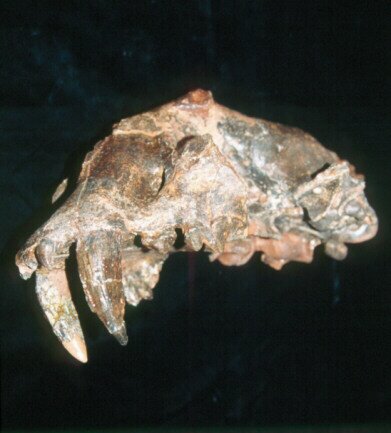|
DINOFELIS email:
The genus Dinofelis includes several species of extinct carnivores often referred to as false saber-tooth cats. They had almost straight dagger-like canines. They have been found in Africa, Eurasia and North America, in Plio-Pleistocene deposits between about 5 and 1.5 million years old. Among the best specimens of Dinofelis barlowi from South Africa are those from Bolts Farm, a world heritage site in the Cradle of Humankind. They have been studied by Professor Basil Cooke (1991, Palaeontologia africa 28, 9-21). One of these skulls (TM BF 55-22) is pictured above, from Bolts Farm Pit 23 recently surveyed by F. Senegas, F. Thackeray, D. Gommery and J. Braga (2002, Annals of the Transvaal Museum 39, 65-67. The postcrania of Dinofelis show that the forelimb had a relatively short forearm, as in the case of leopards. The rear limb seemed to have been relatively gracile. It has been suggested that this extinct carnivore may not have chased down prey, preferring instead to lie in ambush, bringing the prey down with their dagger-like canines. Specimens of Dinofelis barlowi from Bolts Farm Pit 23 (perhaps about 2 million years old) were found with the remains of baboons. Dinofelis piveteaui is represented at Kromdraai A, in deposits which may be about 1.5 years old, together with fossilised remains of alcelaphines such as wildebeest. The teeth of these antelope have been studied by F. Thackeray and T. von Leuvan-Smith (2001, Annals of the Transvaal Museum, 38, 9-12), indicating that most of the individuals represented at Kromdraai were young individuals. Furthermore, chemical analysis of small samples of tooth enamel of Dinofelis suggests that they preyed on animals that ate grass with a C4 photosynthetic pathway. Wildebeest are common in the Kromdraai A faunal assemblage, and they are known to graze on C4 grasses. Together this evidence suggests that antelope such as wildebeest were among the animals preyed upon by Dinofelis. Furthermore, it can be suggested that when Dinofelis preyed upon wildebeest, they focussed primarily on juvelines which were more vulnerable than adults. In this sense, Dinofelis from Kromdraai A behaved in much the same way as lions in the Serengeti, selecting juveniles.
|
